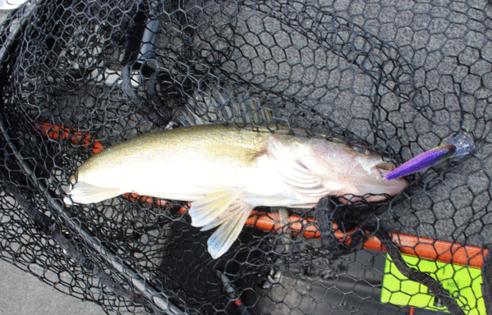Slow-biting walleyes mean anglers can keep more on Mille Lacs
Published in Outdoors
MINNEAPOLIS — Anglers on Mille Lacs Lake will be able to keep an extra walleye soon.
The daily limit will increase from two to three of the fish, after a slow bite this summer has meant fewer fish have been harvested from central Minnesota’s premier walleye lake.
Only about 22% of the state’s annual Mille Lacs walleye quota had been met as of July 15, according to the Department of Natural Resources. Department managers presented the new plan to increase the harvest at a meeting last Wednesday.
“Our plan for Mille Lacs says the state will try to maximize the allowed walleye harvest,” DNR Regional Fisheries Manager Brian Nerbonne said. “Hopefully the bite picks up.”
The DNR aims to put the change into effect by Sept. 1 or sooner.
The agency loosened the walleye bag limit on Mille Lacs this year by allowing anglers to keep two walleyes 17 inches or larger. The size restriction won’t change when a third fish is allowed. Only one of the three keepers can be over 20 inches.
The DNR and Ojibwe with fishing rights on the lake agreed to drastically cut walleye harvest on Mille Lacs more than a decade ago. There were concerns over low survival rates of young walleyes and changing ecological conditions. Last year, for instance, state-licensed anglers could only catch-and-release until Aug. 16.
Nerbonne said 2012 was the last time the daily walleye limit on Mille Lacs was set as high as three fish.
DNR officials said they believed they were taking an aggressive approach this year when they set a two-fish limit starting on opening day. The lake’s walleye population has been growing, with ample quantities of cisco and perch serving as forage. Those factors led state and tribal biologists to increase the 2025 walleye harvest quota by 24% from a year ago. The state’s share rose to 113,600 pounds, while the tribes’ share increased to 88,000 pounds.
At last Wednesday’s meeting of the Mille Lacs Lake Fisheries Advisory Committee, member Steve Kulifaj criticized the DNR for not increasing the bag limit more than it did. The strong population of walleyes will deplete the forage base and put the lake into imbalance, he said.
Nerbonne acknowledged that the walleye bite this summer is slow because there’s a glut of perch and cisco for walleyes to feed upon. But biologists view the situation as beneficial for the lake.
“Fishing is tough this year, but the conditions are helpful for the lake,” Nerbonne said.
The DNR reported that Mille Lacs has a sizable young crop of walleyes averaging about 10 inches. They are too small to keep, but they are easily the most frequently caught class of walleyes. They’ll grow to be spawners and harvestable fish.
Night fishing for walleyes on Mille Lacs will open this year on Sept. 1. But next year, Nerbonne said, night fishing hours may be extended throughout the fishing season. In addition, the DNR might allow additional hours of fishing every night. This year’s night fishing hours will run until 10 p.m., remaining closed until 6 a.m.
At the meeting, the DNR also announced plans to expand muskie stocking in Mille Lacs. The agency stocks about 3,000 muskie fingerlings into the lake every other year. Nerbonne said the agency’s new goal is to stock muskies every year, in larger doses.
Instead of fingerlings, the agency intends to stock 800 yearlings once a year. The yearlings have better survival rates and 800 yearlings is considered equal to the stocking of 4,000 fingerlings.
“We want to increase the population of adult muskies out there,” Nerbonne said.
Even with the expansion, however, muskies will continue to inhabit Mille Lacs at a low density, he said.
____
©2025 The Minnesota Star Tribune. Visit startribune.com. Distributed by Tribune Content Agency, LLC







Comments